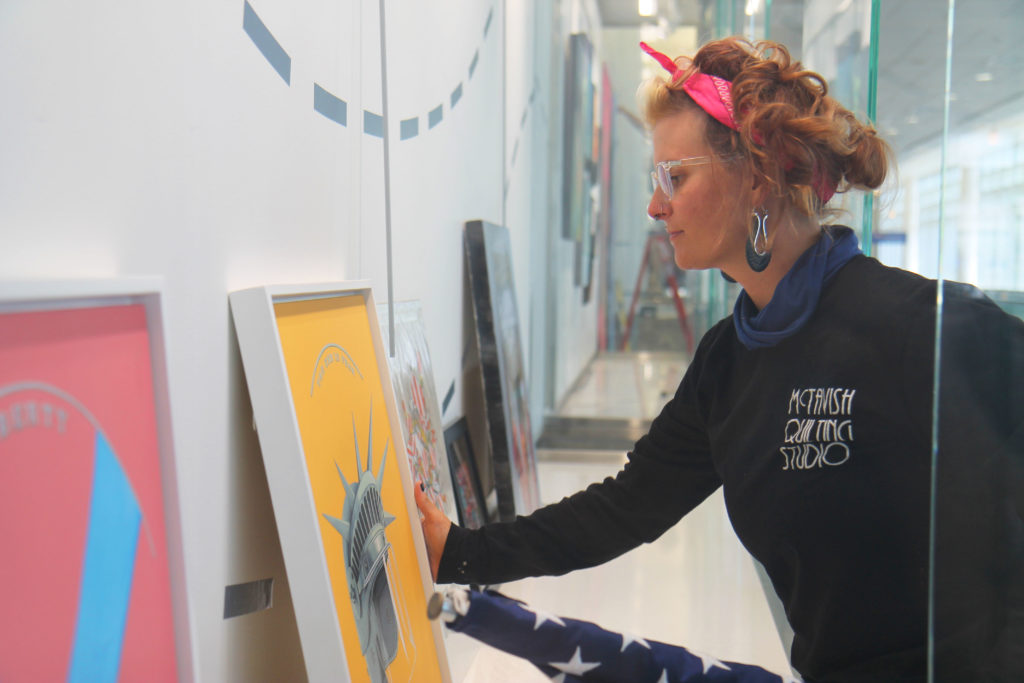Dana Sikkila Flies Her Flag for Creativity
According to Dana Sikkila, she graduated high school “by the skin of [her] teeth.” Months later, she earned a 4.0 in her first semester of college. She attributes the drastic change to the availability of hands-on theater and art courses — “classes where I was around creative adults,” Sikkila explains — in college. Ever since that first semester, she has soaked up textbooks’ worth of learning about fine art, arts administration, and more. Now, she’s a printmaker, educator, gallery director, and biker in Mankato, Minnesota — as well as a Springboard Artist Career Consultant and workshop instructor!
Hi, Dana! Please share a little about your creative practice.
Oh, gosh, that’s a big question. I’m always wearing multiple hats. So I guess my creative practice is a balance of my creative making — as a visual artist or a creative placemaking artist — as well as being an educator within the arts, as well as balancing arts administration. My practice is about doing multiple things at one time within the creative field, which benefits myself but also the people that hire or commission me and [the people] that are just around me to learn.
I grew up in Litchfield, Minnesota, which was kind of a small farm town in West Central Minnesota. I was really creatively driven, with no outlet for creativity. So when I was younger, I was like, “Oh, I’m just different. Or maybe I’m wrong, or I’m weird.” You know, this was in the ’90s. There wasn’t access to arts appreciation or just looking at something visually intriguing that sparked conversation. When we think of Duluth or the Twin Cities, or even places like Rochester, there’s art all over the place, and there’s accessibility to the arts. But when it comes to our smaller communities that are 6000 people [or] 2000 people — I feel those are the communities that are really losing out on the multiple benefits of arts and humanities. When I was younger, if there was more accessibility to creativity, I probably would have had a better outlook on my community; on myself as an individual; my relationship with my family and friends. That is why I do the work now.
How did you start working with Springboard for the Arts?
I think I’ve only been working [with] Springboard for about two years. But when I did my undergrad at Mankato State University, I remember Springboard coming down and doing workshops at the college: [teaching about] marketing and general practice stuff. And I always thought, “Oh, this is really great.” Because at MSU, we didn’t have professional practice courses. They didn’t tell us how to write a grant or how to write an artist statement. So I always appreciated those type of workshops, and eventually, years ago, I remember being like, “My goal is to work for Springboard one day.”
Through my visual practices, I connected with [Springboard]. I did the Hinge Arts Residency. And then one day, they emailed me, and they said, “Hey, we’d love to hire you as a consultant based in southern Minnesota,” and I was like, “Holy shit, here it goes.” I started doing Springboard workshops for our Regional Arts Council down here in southern Minnesota and doing consulting work through them. And my career through Springboard has just grown, in terms of my relationships and what I’m willing to take on.
What are projects that you have going right now or an idea in the making? What’s a project you’d like to see happen?
I’m a big idea person, so I always have like 10 ideas happening. But one project that we actually started from a Springboard “artists in isolation” grant is the Bring Up Banner project. Springboard gave us $500. We took the $500 and bought six sewing machines at the gallery, and then we got a bunch of fabric donated. And we created this program where young people in the community sign up — and it’s all social-distanced and all that, you know, they have their own stations. They come in, and we have a whole conversation on advocacy, and what’s important to them, and what that means living in a place like Mankato. And over the course of two hours, they cut, design, and sew their own advocacy banners at about two feet by four feet. We’ve been displaying them on the exterior of the gallery building as this kind of silent protest.

What’s something you wish others knew about you?
Something that people don’t know about me, I guess, is that I can come off as an extreme extrovert, because that’s part of my job. But I identify as more of an introvert, so when it comes to biking and all these things, I like to have my personal time. When it comes to my own personal time — when it comes to Dana — I totally flip the switch.
Springboard Resources
Artist Career Consultants, available for virtual consultations: https://springboardforthearts.org/consultants/
Workshops & Events Calendar: https://springboardforthearts.org/events/
Work of Art and Handbook for Artists Working in Community books: https://springboardforthearts.org/buy-books/
Editor’s note: As the national platform for Springboard for the Arts, Creative Exchange has long been a platform to highlight the artists, resources, and efforts in our national network. In this pandemic, as Springboard for the Arts’ work is increasingly online and accessible nationally, we’ll be turning the spotlight on Springboard staff and our Artist Career Consultants, to share more about who we are and the work we do. Enjoy!
